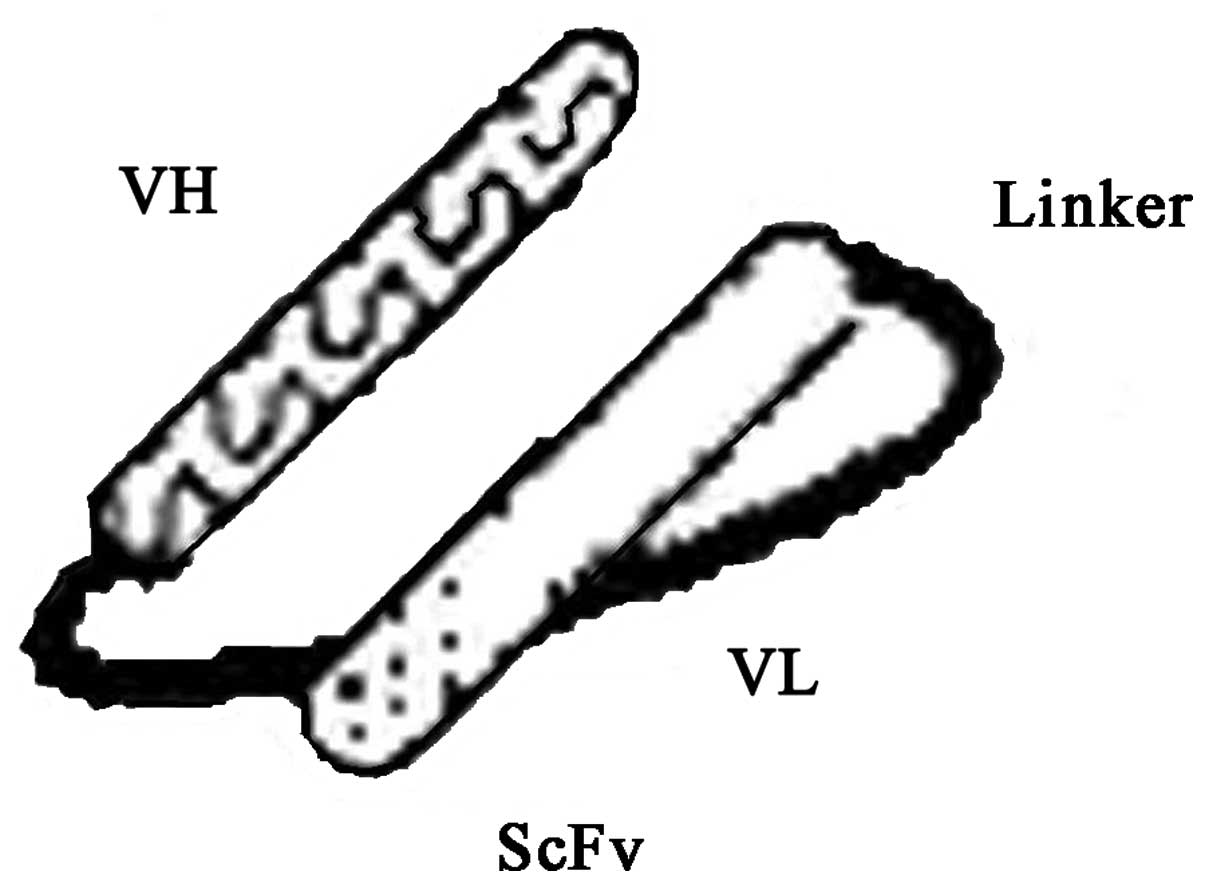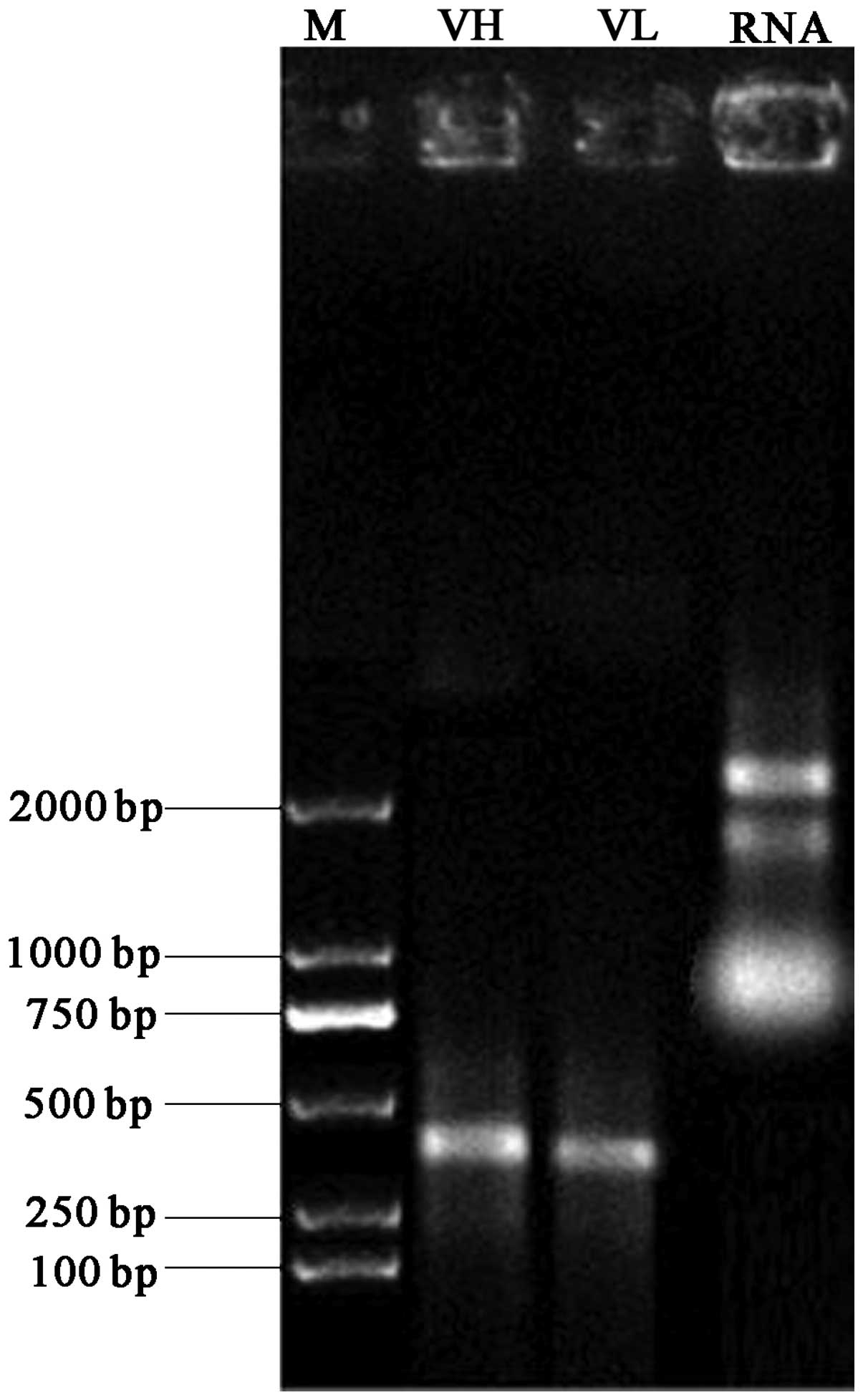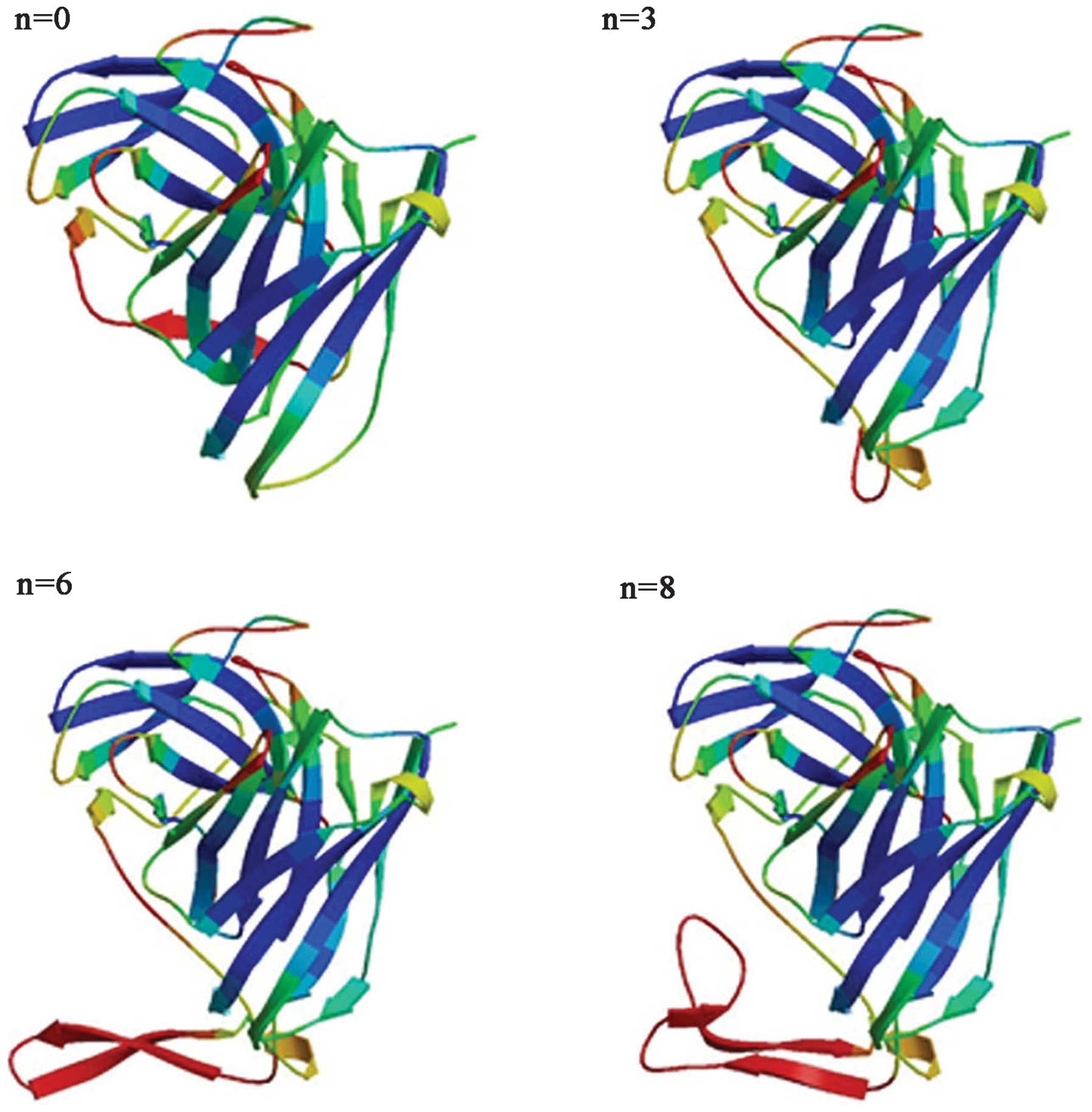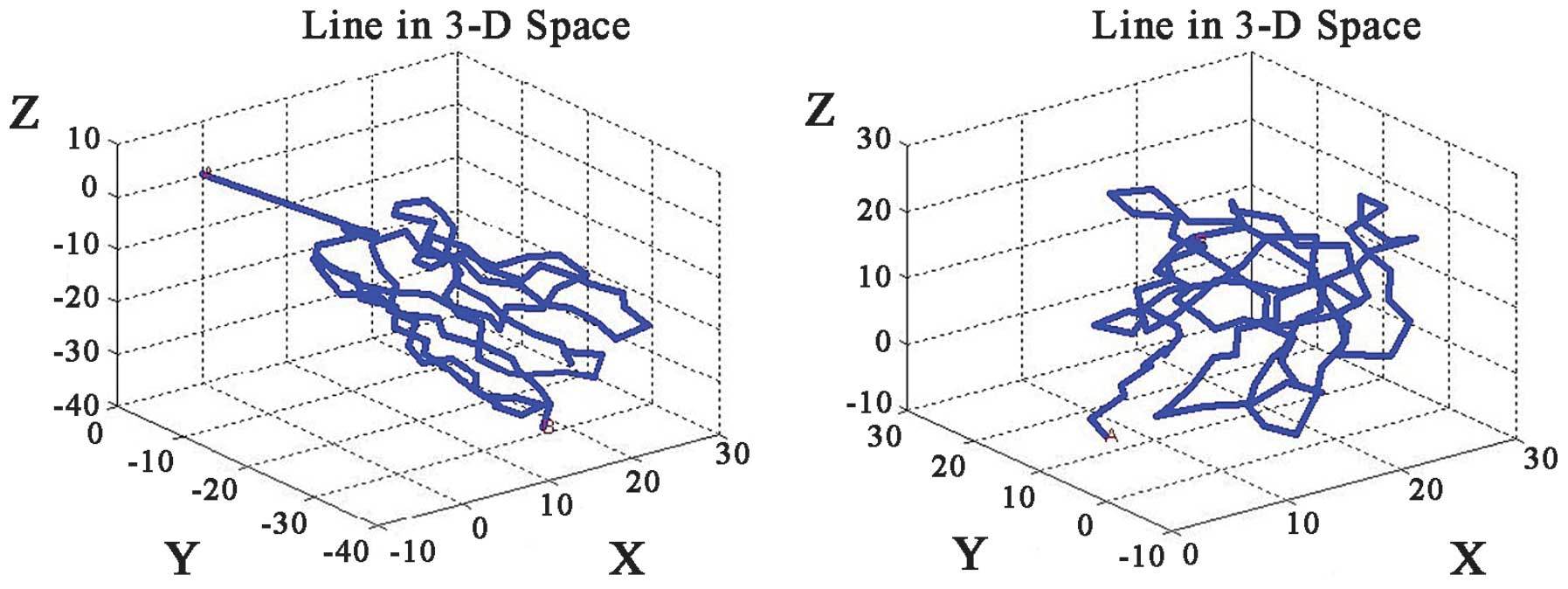Investigation of the structure of anti‑human seminal plasma protein single‑chain antibody and its association with linker peptide length
- Authors:
- Published online on: June 22, 2015 https://doi.org/10.3892/mmr.2015.3980
- Pages: 4117-4122
-
Copyright: © Jiang et al. This is an open access article distributed under the terms of Creative Commons Attribution License [CC BY_NC 3.0].
Abstract
Introduction
Prostate cancer refers to epitheliogenic malignant tumors of the prostate. What is usually termed prostate cancer refers to adenocarcinoma of the prostate. Since the mid to late 1980s, the morbidity and mortality rates of prostate cancer in certain developed areas in China have continued to increase (1). Previous studies have indicated that seminal plasma protein is one of the specific markers of prostate cancer (2). Hao and Liang (3) used 131I to mark the anti-human seminal plasma protein single-chain antibody (γ-Sm-McAb), which was used for the radioimmunoimaging and treatment of prostate cancer. This method was confirmed to be of high sensitivity and specificity, and of beneficial therapeutic effect (3). However, the monoclonal antibodies used originated from murine animals, the repeated use of which may generate anti-mouse antibodies, affecting the therapeutic effect and resulting in allergic reactions (4). Due to the small molecular size, low antigenicity and advantages over other parental antibodies when used within the body, a single chain variable fragment (ScFv) can be used to effectively avoid deficiencies in monoclonal antibodies and has received increasing attention (5). A ScFv is composed of a heavy chain (VH) and a light chain (VL) through linkers of several amino acids (6) (Fig. 1). VH and VL are the minimum functional fragments in the binding site of antibodies to antigens, while the linker peptide is used predominantly for connection between the two for fusion expression. (Gly4Ser)n is usually selected as the linker peptide in ScFv (7), however, the effect of the of the selected n-value on the functional expression of the two variable regions in ScFv is key to investigating the optimal construct of ScFv. In the present study, a similarity algorithm of spherical coordinates for layered proteins was used. Comparison of changes in the structural models of the changeable structures in single-chain antibodies under different values of n, enable the optimal linker length to be determined for maintaining active seminal plasma protein single-antibodies. The results of the present study aim to provide a foundation for the preparation of a single-chain antibody, which may be effective in the treatment of prostate cancer.
Materials and methods
Preparation of monoclonal antibody
The anti-human seminal plasma protein hybridoma cell strain was provided by The First Affiliated Hospital of Zhengzhou University (Zhengzhou, China), which was used for secretion of the monoclonal antibody of anti-human seminal plasma protein. Plasmids of Escherichia coli JM109 (pUC19) were preserved in the laboratory (First Affiliated Hospital of Zhengzhou University). The restriction endonuclease, Taq DNA polymerase, dNTP, buffer, purification system of Wizard™Plus Minipreps and the expression vector of the Glutathione S-transferase fusion protein (pGEX-4T-1) were purchased from Promega Corporation (Fitchburg, WI, USA); The rapid DNA ligation kit was purchased from Boehringer Mannheim GmbH (Basel, Switzerland); The Advantage™PCR-Pure kit was purchased from Clontech Co. (Tokyo, Japan).
The key instruments used in the present study included a polymerase chain reaction (PCR) DNA Amplifier, a pipettor and refrigerated centrifuge (Eppendorf, Hamburg, Germany), a GFL-7601 incubator (GFL Company, Lower Saxony, Germany), a water bath (Shanghai Senxin Biological Technology Co., Ltd., Shanghai, China), a horizontal electrophoresis apparatus, a gel imaging system (Liyyi Company, Beijing, China) and a −80°C ultra cold storage freezer (Haier, Beijing, China).
Extraction and reverse transcription of total cellular (c)DNA
The extraction of total cDNA was performed was performed using the DNA one step extraction method, as described previously (8). The total RNA was extracted from the cells and dissolved in 30 µl RNase-free water, and reverse transcription was performed using 5 µl, according to the manufacturer's instructions (Promega Corporation).
Amplification of variable region genes of the monoclonal antibody
The genes of VH and VL were amplified using 672 ng/µl template cDNA. The primer sequences were as follows: VH, reverse 5′-AGGT (CG) (AC) A (AG) CTGCAG (CG) AGTC (AT) GG-3′ (degenerate primer) and forward 5′-TGAGGAAACGGTGACCGTGGTCCCTTGGCCCCAG-3′; VL, reverse 5′-GTGAATTCGACATCGTGATGACCCAGTCTCC-3′ and forward 5′-CAGTCGACTAACGTTTGATCTCCAGCTTGGTCCC-3′ (Sangon Biotech, Shanghai, China). The PCR reaction system (20 µl) included cDNA (1 µl), dNTP (0.4 µl), upstream and downstream primers (each 0.3 µl), Taq DNA polymerase (0.2 µl), buffer (2 µl) and sterilized water (15.8 µl). The reaction conditions included a denaturing stage for 60 sec at 94°C, annealing for 90 sec at 55°C, extension for 120 sec at 72°C, for 30 cycles. Following extracting 5 µl amplicon from each of the VH and VL samples to perform the lipid sugar electrophoresis detection, the remaining amplicon was recycled by Advantage™PCR-Pure kit according to the manufacturer's instructions and then was sequenced by the Shenggong Bioengineering Limited Company (Shanghai, China).
Modeling
The corresponding amino acid sequence was acquired by translating VH and VL gene sequences in γ-Sm-ScFv. The amino acid sequence of the protein determined the advanced structure. Firstly, tertiary-structure modeling of VH and VL were performed using the homologous modeling method. The amino acid sequences of VH and VL were sent to SWISS-MODEL for modeling (http://www.swissmodel.expasy.org/), and the acquired data file of the protein data bank structure was treated as the original structural file.
A total ScFv sequence can be combined by adding linker amino acid sequences and connecting them between VH and VL. Among which, (Gly4Ser)n was selected for the linker sequence. (Gly4Ser) refers to five short amino acid peptides, which are composed of four glycines and one serine. This oligopeptide is a repeated unit in the linker peptide, which is used for ligation of the VL and VH segments. It has relatively high flexibility or bending capacity. The small steric hindrance is useful for the interaction of the VL and VH segments, and arrangement of the correct conformation, as well as improving the stability of antibodies. Such structure is not easily recognized or degraded by proteases, which contributes to the stability of antibodies within the body. The combinatorial ScFv-n sequence was also used in the modeling, and the data of the overall three-dimensional structure and that of VHn and VLn were obtained.
Structural contrast
To investigate the effect of the length of the linker peptide on the structure of VH and VL, the structural similarity of VH and VL in (Gly4Ser)n was calculated at different values of n. In addition, a space spherical shell hierarchical matching algorithm, based on spherical coordinates and described by Zhang and Chen (9), was used to calculate the level of similarity. In this algorithm, the protein was treated as the spherome, and the euclidean coordinates of each atom in the protein were transformed into spherical coordinates. According to the radius, the protein was then divided into several layers of spherical shells, and the same number of same atoms in each layer were collected. On the basis of predetermined weights, the number of atoms were determined, thus, obtaining the final value of atoms in each layer. Each layer of atomic values of VH-(Gly4Ser)n or VL-(Gly4Ser)n and VH (or VL) were stacked into vector a and vector b, respectively. The included angle cosine function was treated as a similarity function. The formula used (1), the algorithm of which was achieved using MATLAB 2012a software (The MathWorks, Inc., Natick, MA, USA) was as follows:
Stability analysis
The stability of ScFv is presented as the fore and aft distance or the diffusion radius. The fore and aft distance refers to the distance from the fore α-carbon atom to the aft α-carbon atom. Using MATLAB, the fore and aft distances of the original structure of VH and VL were calculated, respectively, adding the fore and aft distances of VHn and VLn when n=0–9. In addition, their largest diffusion radius was calculated.
Results
The optical density (OD)260/OD280 value of the overall extracted mRNA was 2.1, according and its concentration was 1,279 ng/µl, which met the requirements of the experiment. The concentration of cDNA transcribed by reverse transcription was 672 ng/µl. The cDNA was diluted at 1:50 and was used to amplify of the VH and the VL of the seminal plasma protein's single-chain antibody using PCR. The results of the electrophoresis are shown in Fig. 2.
The results of the VH and VL modeling in ScFv using the homologous modeling method are shown in Figs. 3 and 4. Generally, the length of the linker peptide of ScFv was between 10 and 40 amino acids long. The longer the length of the linker peptide, the less stable the structure of the ScFv. During the process of modeling, when n=9 (linker peptide length of 45 amino acids), modeling failed due to the low homology of the searched templates. Therefore, three-dimensional models were obtained when the n-value was between 0 and 8, and the results of the modeling are shown in Fig. 4. Each model had corresponding data for the VHn and VLn structure and data for the overall ScFv-n structure.
From the figures described above, there was a clear difference in the structural models between VH/VL alone and VH/VL when the linker was added, and the structure of the linker changed markedly as its length changed. Subsequently, the protein similarity algorithm, based on delamination of the spherical coordinates, was used to provide a contrast in the VH and VL similarity prior to and following addition of the linker. The results of the algorithm are shown in Table I.
Following several trials, the similarity data was relatively accurate and stable when the protein was divided into three layers. To guarantee the accuracy of the results, the protein was divided into 2, 3 and 4 layers. Subsequently, the mean similarity value of the data in each group was calculated and treated as the final result. As shown in Table I, when n=3 and n=6, the similarity data obtained was close to the original data of VH and VL. The similarity has indicated the effect of the linker peptide's length on the variable region structure to the ScFv, and the larger the value of the similarity, the lower the effect, which represented that the effect on the biological activity of a single-chain may be smaller.
Following the addition of the linker, the stability of VH and VL was analyzed again, based on the fore and aft distance and the diffusion radius. The results are shown in Table II.
Table IIChanges of the fore and aft distance and radius of VH, VL and linker prior to and following addition of the linker. |
As shown in Table II, when n=6, the fore and aft distance (40.3791) of the VH was the closest to that of VH (39.9601); when n=3, in which the diffusion radius (25.6413) was also closest to the original data (25.2179). By contrast, in the VL, the fore and aft distance following addition of the linker reduced to almost half that of the original data, however, the diffusion radius increased. In addition, when n≤3, the fore and aft distance of the linker increased as the length of the peptide increased, whereas, when n>3, the fore and aft distance decreased due to folding of the lengthened peptide chain. The changes in the fore and aft distance also affected VH and VL. The position comparison in the space coordinates system of the original VH, VL and the α carbon atoms of the ScFv-n structure was established by MATLAB 2012a, as is shown in Figs. 5 and 6, which suggested the fore and aft distance change of VH and VL was as expected. This indicated that after adding linker peptides of different lengths, the change in the whole molecular radius was small.
Discussion
From the comparative investigation performed in the present study, it was concluded that, in the spatial distribution of analogous proteins, the three-dimensional structure of proteins was more conserved than the primary sequence. The prediction of target protein spatial conformation is more reliable when performed in analogous proteins (10), and there have been several previous successes in predicting the structure of antibodies (10,11). Successful modeling of the 6B4 antithrombotic antibody by Fontayne et al (11) laid a foundation for the investigation of its antithrombotic activity and antigenicity Modeling of the three-dimensional structure of a protein can assist in the modification of the original antibodies on the basis of understanding its spatial structure and physiological functions, and it is significant for antibody engineering. ScFv molecule is a small molecule with weak immunogenicity and a rapid response time. It has no cumulative action in the kidney and its sharpness and clarity in tumor imaging is high, which enable it to be used as a vector and combined with medicine, isotopes and toxins (12). Single-chain antibody constructs belong to minimolecular antibodies. They are constructed by VH, VL and linker peptides, and are the smallest functional fragments of antibodies in retention of the antigen-binding site, which has significant theoretical and applicable value in the diagnosis and treatment of cancer.
In the present study, a series of methods, including modeling and bioinformatics, were used to examine and compare the structural changes in ScFv when the length of the linker peptide was altered. (Gly4Ser)n, as a linker peptide, is often selected in single-chain antibodies, among which 'Gly' represents glycine, 'Ser' represents serine and 'n' indicates the number of (Gly4Ser). The results of the present study revealed that, following addition of the linker, the similarity data for VH and VL was closest to that of the original data when n=3 and n=6, which indicated that ScFv-3 and ScFv-6 were closest to the original structure, as was their biological activity. In terms of stability, the fore and aft distance, and the diffusion radius of the VH and VL altered to different degrees following addition of the linker. Notably, when n=6, the fore and aft distance of the VH was closest to the original data, while that of the VL decreased by half. Compared with the original radius, that of VH and VL increased. When n=3, however, the diffusion radius of the VH was the closest to the original data. The majority of the results indicated the the significance of the effect of linkers n=3 and n=6 on VH and VL.
Despite the construction of ScFv or a single-strand bispecific antibody, the linker peptide cannot affect the folding of the structure of an antibody or its biological activities (13). Several studies have investigated the effect of the length of linkers on the activities of ScFv (14). Kikuchi et al (15) constructed an anti-CD47 bivalent single-chain antibody, MABLsc(Fv), by way of covalence, using linkers of 15 amino acids (Gly4Ser); Yan et al (16) found that a linker length of 15 amino acids was more favorable for the folding of antibodies, guaranteeing the affinity of the bivalent single-chain antibodies. Goel et al (17) successfully constructed bivalent single-chain antibodies with immune activity using a longer linker of 25 amino acids. The present study confirmed that when n=3 (linker with 25 amino acids), the two variable regions in the ScFv were closest to the original structure. The results also demonstrated that, when n=6, the effect of the linker on the structure of ScFv was smaller. Considering that the present study used a bioinformatics approach, and that there may be a certain level of error in molecular modeling, the results of the present study require confirmation using biological experiments. Whether a linker length of 30 amino acids is suitable for the favorable expression of biological activity in a single-chain antibody also requires further investigation.
The effects of structural changes of linker peptides in single-chain antibodies on the whole antibody molecules were examined using mathematical modeling and bioinformatics methods, providing a basis for further investigation of the preparation of single-chain antibodies.
Acknowledgments
The authors would like to thank their colleagues within the department for their general support. This study was supported by the National Natural Science Foundation of China (grant no. 60971110), the Science and Technology Corporation Project of Henan Province (grant no. 122106000042) and the Open Science and Technology Corporation Project of Henan Province in 2013 (grant no. 132106000064).
References
|
Peng P, Gong YM, Bao PP, et al: Estimates and prediction of prostate cancer incidence, mortality and prevalence in China in 2008. Zhonghua Liu Xing Bing Xue Za Zhi. 33:1056–1059. 2012.In Chinese. | |
|
Arai Y, Yoshiki T, Okada K and Yoshida O: Multiple marker evaluation in prostatic cancer using prostatic specific antigen, gamma-seminoprotein and prostatic acid phosphatase. Urol Int. 44:135–139. 1989. View Article : Google Scholar : PubMed/NCBI | |
|
Hao XK and Liang GD: Diagnosis of prostate cancer by radioim-munoimaging of 131I-antihuman seminal plasma protein. Natl Med J China. 73:655–657. 1993. | |
|
Hao XK, Wu GJ, Bai YJ, Yao LB, Zhang YH and Gao L: Construction and expression of single-chain Fv Genes of Anti-human seminal plasma protein. Chin J Urol. 29:30–32. 1999. | |
|
Fei JX, Ren J and Miao JY: Research on the Construction, expression and clinical application of single-chain antibody. Shaanxi Med J. 29:30–32. 2000. | |
|
Wu HG and Yan DF: Construction and expression of the variable region of single-chain antibody. J Taizhou Teach Coll. 17:55–59. 1995. | |
|
Yang LJ, Hou YC, Bai YJ, Yao LB and Su CZ: Analysis of primary structure and modeling of spatial structure of single-chain variable region of antibody against human gastric cancer. Shijie Huaren Xiaohua Zazhi. 16:2333–2336. 2008. | |
|
Chomczynski P and Sacchi N: Single-step method of RNA isolation by acid guanidinium thiocyanate-pheno-chloro form extraction. Anal Biochem. 162:156–159. 1987. View Article : Google Scholar : PubMed/NCBI | |
|
Zhang JH and Chen ZT: Analyzing influence on the conformation of single-chain antibody with the differential length of linkers. Afr J Microbiol Res. 5:5737–5744. 2011. | |
|
Thompson AJ, Price KL, Reeves DC, Chan SL, Chau PL and Lummis SC: Locating an antagonist in the 5-HT3 receptor binding site using modeling and radioligand binding. J Biol Chem. 280:20476–20482. 2005. View Article : Google Scholar : PubMed/NCBI | |
|
Fontayne A, Vanhoorelbeke K, Pareyn I, Van Rompaey I, Meiring M, Lamprecht S, Roodt J, Desmet J and Deckmyn H: Rational humanization of the powerful antithrombotic anti-GPIbalpha antibody: 6B4. Thromb Haemost. 96:671–684. 2006.PubMed/NCBI | |
|
Colcher D, Bird R, Roselli M, Hardman KD, Johnson S, Pope S, Dodd SW, Pantoliano MW, Milenic DE and Schlom J: In vivo tumor targeting of a recombinant single-chain antigen-binding protein. J Natl Cancer Inst. 82:1191–1197. 1990. View Article : Google Scholar : PubMed/NCBI | |
|
Fang Ming, Jiang Xin and Yang Zhi: Influences of connecting peptide between the chain on the biological activity of ScBsAb. Chin Sci Bull. 48:1912–1918. 2003. | |
|
Zhang J, Shang Z and Zhang X: The optimization design of single bivalent connecting peptide antibodies. Math Med Biol. 21:602–605. 2008. | |
|
Kikuchi Y, Suzuki Y and Tamiya N: The source of oxygen in the reaction catalysed by collagen lysyl hydroxylase. Biochen J. 213:507–512. 1983. | |
|
Yan D, Fang J and Song J: Construction and Expression of Bivalent Single-chain Antibodies with Different Linker Sequence Against Human Colorectal Carcinoma. J Cell Biol. 29:272–276. 2007. | |
|
Goel A, Colcher D, Baranowska-Kortylewicz J, et al: Genetically engineered tetravalent single-chain Fv of the pan carcinoma monoclonal antibody CC49: improved bio distribution and potential for therapeutic application. Cancer Res. 60:6964–6971. 2000. |















